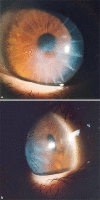Penetrating keratoplasty after radial keratotomy and recurrent immune overreaction
- PMID: 21532987
- PMCID: PMC3084040
- DOI: 10.1159/000324750
Penetrating keratoplasty after radial keratotomy and recurrent immune overreaction
Abstract
A 32-year-old man suffering from keratoconus was treated with radial keratotomy. Twenty weeks later, he presented visual deterioration, edema and corneal perforation. A penetrating keratoplasty was required. The postoperative course was regular, but after 9 months, the patient presented kerato-uveitis. Subsequent phlogistic relapses occurred approximately every 6 months during the following 5 years. The performed cultures were positive only during the first episode. Radial keratotomy is not indicated in keratoconus. The multiple relapses of kerato-uveitis could not be explained by infection, and we hypothesized that they may be due to a 'traumatic memory' of the cornea caused by the several suffered traumatisms, without clinical features of corneal graft rejection. The risks of new penetrating keratoplasty and cataract surgery are high. As the cornea is the tissue with the highest sensitivity in the body, we tried to explain the relapsing kerato-uveitis as a consequence of the disruption of the nervous corneal network.
Keywords: Kerato-uveitis; Keratoconus; Penetrating keratoplasty; Radial keratotomy; Recurrent immune overreaction; Traumatic memory.
Figures
Similar articles
-
Penetrating keratoplasty in keratoconic eyes with prior radial keratotomy.Eur J Ophthalmol. 2010 Jan-Feb;20(1):35-40. Eur J Ophthalmol. 2010. PMID: 19927271
-
[Corneal transplantation of a corneal graft with radial keratotomy].J Fr Ophtalmol. 2006 Jun;29(6):651-3. doi: 10.1016/s0181-5512(06)73826-8. J Fr Ophtalmol. 2006. PMID: 16885895 French.
-
Late complications of combined radial and transverse keratotomy after penetrating keratoplasty associated with atopic keratoconjunctivitis.Refract Corneal Surg. 1989 May-Jun;5(3):194-7. Refract Corneal Surg. 1989. PMID: 2484950
-
Current surgical options for keratoconus.J Cataract Refract Surg. 2003 Feb;29(2):379-86. doi: 10.1016/s0886-3350(02)01968-5. J Cataract Refract Surg. 2003. PMID: 12648653 Review.
-
Histopathology of traumatic corneal rupture after radial keratotomy.Arch Ophthalmol. 1988 Nov;106(11):1584-90. doi: 10.1001/archopht.1988.01060140752050. Arch Ophthalmol. 1988. PMID: 3056355 Review.
Cited by
-
Descemet membrane endothelial keratoplasty for endothelial decompensation after previous radial keratotomy.Am J Ophthalmol Case Rep. 2019 Jun 28;15:100503. doi: 10.1016/j.ajoc.2019.100503. eCollection 2019 Sep. Am J Ophthalmol Case Rep. 2019. PMID: 31317085 Free PMC article.
-
A Combined Procedure of Intrastromal Corneal Rings Explantation and Penetrating Keratoplasty in a Patient With Keratoconus: A Case Report.Front Med (Lausanne). 2022 Mar 11;9:853702. doi: 10.3389/fmed.2022.853702. eCollection 2022. Front Med (Lausanne). 2022. PMID: 35360745 Free PMC article.
References
-
- Weed KH, McEwen CJ, Giles T, Low J, McGhee CN. The Dundee University Scottish Keratoconus study: demographics, corneal signs, associated diseases, and eye rubbing. Eye. 2008;22:534–541. - PubMed
-
- Lois N, Kowal VO, Cohen EJ, Rapuano CJ, Gault JA, Raber IM. Indications for penetrating keratoplasty and associated procedures, 1989–1995. Cornea. 1997;16:623–629. - PubMed
-
- Nishida T. The cornea: stasis and dynamics. Nippon Ganka Gakkai Zasshi. 2008;112:179–212. - PubMed
-
- Durand L, Monnot JP, Burillon C, Assi A. Complications of radial keratotomy: eyes with keratoconus and late wounds dehiscence. Refract Corneal Surg. 1992;8:311–314. - PubMed
-
- Wagoner MD, Ba-Abbad R, Al-Mohaimeed M, Al-Swailem S, Zimmerman MB. King Khaled Eye Specialist Hospital Cornea Transplant Study Group. Postoperative complications after primary adult penetrating keratoplasty: prevalence and impact on graft survival. Cornea. 2009;28:385–394. - PubMed


